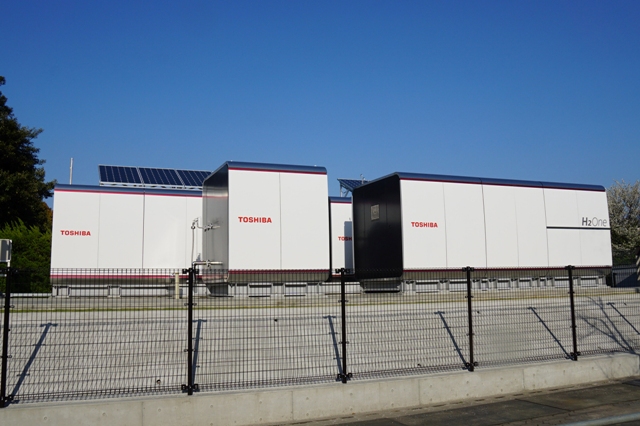Apr 20 2015
Toshiba Corporation today announced the start of demonstration operation of H2One, an independent energy supply system based on renewable energy and use of hydrogen as a fuel for power generation. Kawasaki City and Toshiba have installed the system at the Kawasaki Marien public facility and Higashi-Ogishima-Naka Park in the Kawasaki Port area.
 Picture of H2One (Photo: Business Wire)
Picture of H2One (Photo: Business Wire)
H2One combines photovoltaic installations, storage batteries, hydrogen-producing water electrolysis equipment, hydrogen and water tanks, and fuel cells. Electricity generated from the photovoltaic installations is used to electrolyze water and produce hydrogen, which is then stored in tanks and used in fuel cells that produce electricity and hot water.
Since H2One uses only sunlight and water for fuel, it can independently provide electricity and hot water in times of emergency, even when lifelines are cut. Kawasaki Marien and Higashi-Ogishima-Naka Park, a municipal facility to promote Kawasaki Port, is a designated emergency evacuation area. In times of disaster, H2One will use stored hydrogen to provide an estimated 300 evacuees to the site with electricity and hot water for about one week. The H2One system is housed in a container, and can be transported to disaster-hit areas on trailers.
In normal, non-emergency operation, H2One’s hydrogen energy management system is used to contribute to peak shift, which reduces demand for mains power at times of high demand, through optimized control of hydrogen production, power generation and storage. Toshiba is working to enhance its hydrogen storage capabilities to realize a self-contained solution of local energy production for local consumption.
The demonstration project will verify the effectiveness of a hydrogen-based emergency electric power and hot-water supply system and a hydrogen energy management system in normal operating circumstances at both of the Kawasaki sites. It will also support improvement of overall system efficiency.
Toshiba is committed to creating a safe, secure and comfortable society, the “Human Smart Community,” that includes production of hydrogen from water by electrolysis powered by renewable energy sources. To achieve this commitment, Toshiba will combine wide-ranging technologies from across Toshiba Group.
|
Outline of Demonstration
|
| Installation sites |
|
Kawasaki Marien and Higasi-Ogishima-Naka Park |
| Period |
|
April 20, 2015 to March 31, 2021 |
| Demonstration |
|
• Operation of the hydrogen energy management system under normal circumstances
• Operation of the hydrogen-based business continuity system in times of disaster
|
| Key specifications |
|
Hydrogen production: 1 m3 maximum per hour
|
| |
Hydrogen consumption: 2.5 m3 maximum per hour
|
| |
Hydrogen tank storage capacity: 33 m3 maximum (270 Nm3, 0.8 MPa)
|
| |
Hot water supply capacity: 75 liters maximum per hour (40 °C) |
| |
Photovoltaic facility: 30 kW |
| |
Fuel cell output: 3.5 kW maximum |
| |
Electricity storage capacity: 350 kWh |
| |
Fuel cell efficiency: 95% (55% for electricity and 40% for hot water) |